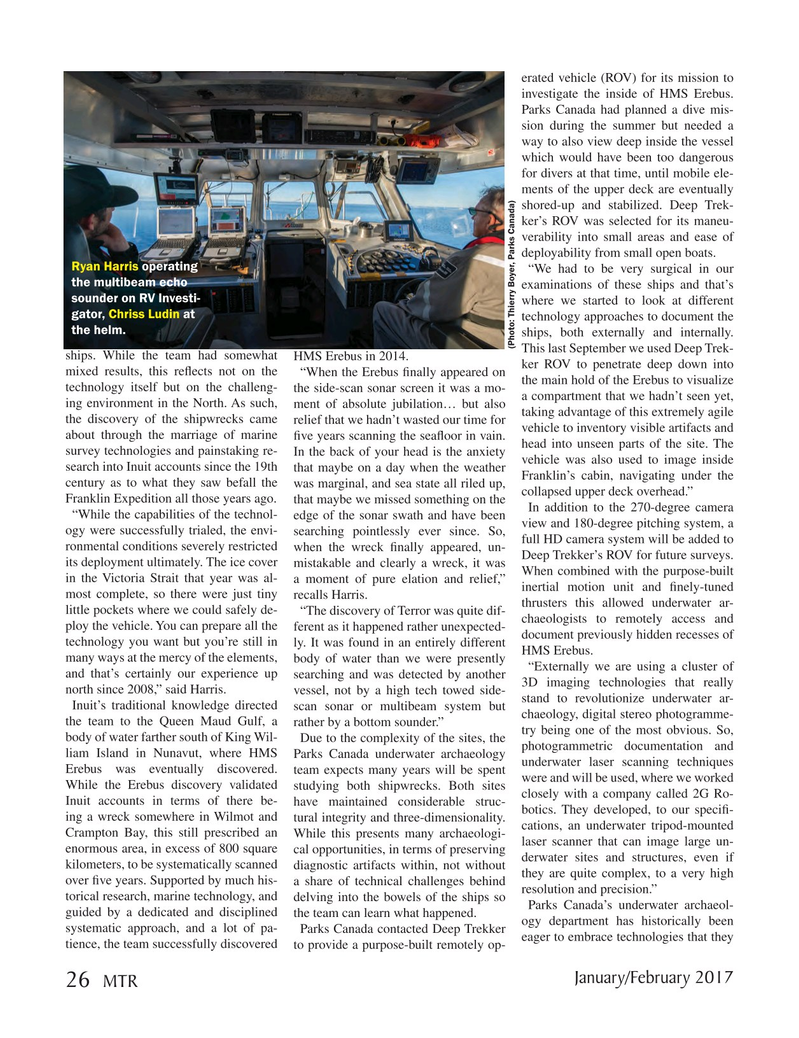
Page 26: of Marine Technology Magazine (January 2017)
Underwater Vehicle Annual: ROV, AUV, and UUVs
Read this page in Pdf, Flash or Html5 edition of January 2017 Marine Technology Magazine
erated vehicle (ROV) for its mission to investigate the inside of HMS Erebus.
Parks Canada had planned a dive mis- sion during the summer but needed a way to also view deep inside the vessel which would have been too dangerous for divers at that time, until mobile ele- ments of the upper deck are eventually shored-up and stabilized. Deep Trek- ker’s ROV was selected for its maneu- verability into small areas and ease of deployability from small open boats.
Ryan Harris operating “We had to be very surgical in our the multibeam echo examinations of these ships and that’s sounder on RV Investi- where we started to look at different gator, Chriss Ludin at technology approaches to document the the helm. ships, both externally and internally. (Photo: Thierry Boyer, Parks Canada)
This last September we used Deep Trek- ships. While the team had somewhat HMS Erebus in 2014. ker ROV to penetrate deep down into mixed results, this re? ects not on the “When the Erebus ? nally appeared on the main hold of the Erebus to visualize technology itself but on the challeng- the side-scan sonar screen it was a mo- ing environment in the North. As such, ment of absolute jubilation… but also a compartment that we hadn’t seen yet, taking advantage of this extremely agile the discovery of the shipwrecks came relief that we hadn’t wasted our time for vehicle to inventory visible artifacts and about through the marriage of marine ? ve years scanning the sea? oor in vain. head into unseen parts of the site. The survey technologies and painstaking re- In the back of your head is the anxiety vehicle was also used to image inside search into Inuit accounts since the 19th that maybe on a day when the weather
Franklin’s cabin, navigating under the century as to what they saw befall the was marginal, and sea state all riled up, collapsed upper deck overhead.”
Franklin Expedition all those years ago. that maybe we missed something on the
In addition to the 270-degree camera “While the capabilities of the technol- edge of the sonar swath and have been ogy were successfully trialed, the envi- searching pointlessly ever since. So, view and 180-degree pitching system, a full HD camera system will be added to ronmental conditions severely restricted when the wreck ? nally appeared, un-
Deep Trekker’s ROV for future surveys. its deployment ultimately. The ice cover mistakable and clearly a wreck, it was in the Victoria Strait that year was al- a moment of pure elation and relief,” When combined with the purpose-built inertial motion unit and ? nely-tuned most complete, so there were just tiny recalls Harris.
thrusters this allowed underwater ar- little pockets where we could safely de- “The discovery of Terror was quite dif- chaeologists to remotely access and ploy the vehicle. You can prepare all the ferent as it happened rather unexpected- document previously hidden recesses of technology you want but you’re still in ly. It was found in an entirely different many ways at the mercy of the elements, body of water than we were presently HMS Erebus.
“Externally we are using a cluster of and that’s certainly our experience up searching and was detected by another 3D imaging technologies that really north since 2008,” said Harris. vessel, not by a high tech towed side-
Inuit’s traditional knowledge directed scan sonar or multibeam system but stand to revolutionize underwater ar- chaeology, digital stereo photogramme- the team to the Queen Maud Gulf, a rather by a bottom sounder.” try being one of the most obvious. So, body of water farther south of King Wil- Due to the complexity of the sites, the liam Island in Nunavut, where HMS Parks Canada underwater archaeology photogrammetric documentation and underwater laser scanning techniques
Erebus was eventually discovered. team expects many years will be spent
While the Erebus discovery validated studying both shipwrecks. Both sites were and will be used, where we worked closely with a company called 2G Ro-
Inuit accounts in terms of there be- have maintained considerable struc- botics. They developed, to our speci? - ing a wreck somewhere in Wilmot and tural integrity and three-dimensionality. cations, an underwater tripod-mounted
Crampton Bay, this still prescribed an While this presents many archaeologi- laser scanner that can image large un- enormous area, in excess of 800 square cal opportunities, in terms of preserving derwater sites and structures, even if kilometers, to be systematically scanned diagnostic artifacts within, not without over ? ve years. Supported by much his- a share of technical challenges behind they are quite complex, to a very high resolution and precision.” torical research, marine technology, and delving into the bowels of the ships so
Parks Canada’s underwater archaeol- guided by a dedicated and disciplined the team can learn what happened. ogy department has historically been systematic approach, and a lot of pa- Parks Canada contacted Deep Trekker eager to embrace technologies that they tience, the team successfully discovered to provide a purpose-built remotely op-
January/February 2017 26 MTR
MTR #1 (18-33).indd 26 MTR #1 (18-33).indd 26 1/24/2017 10:27:25 AM1/24/2017 10:27:25 AM

 25
25

 27
27
